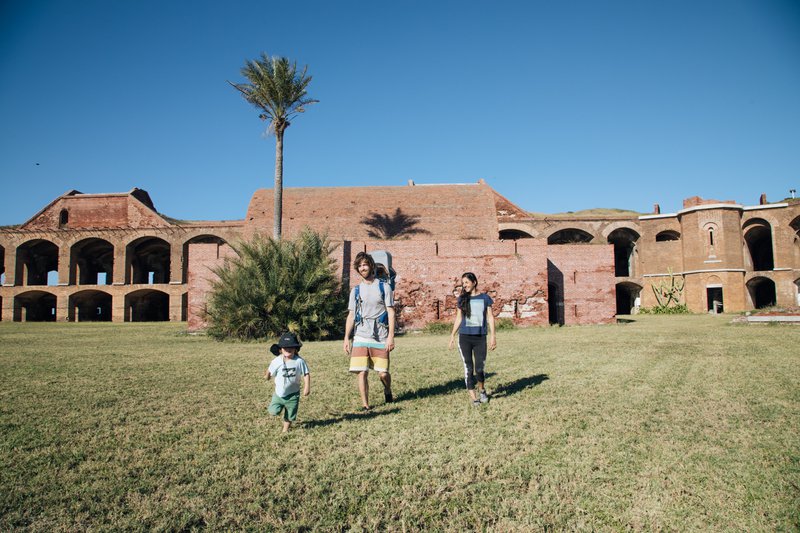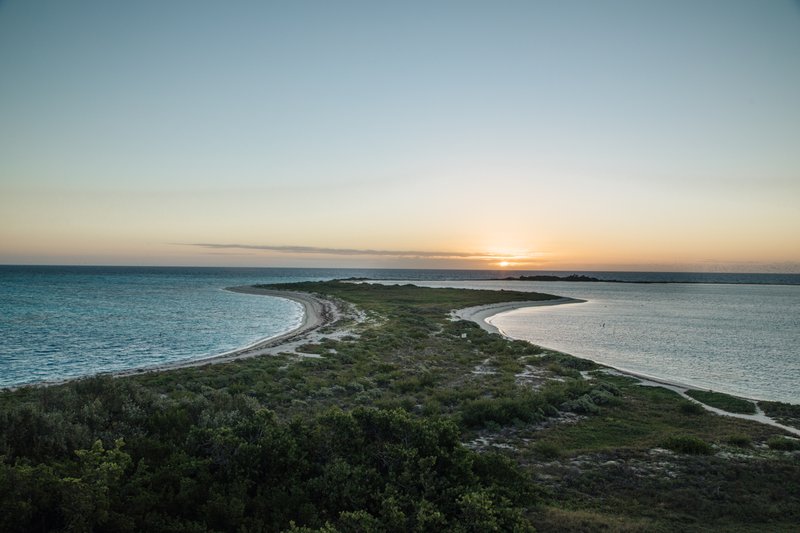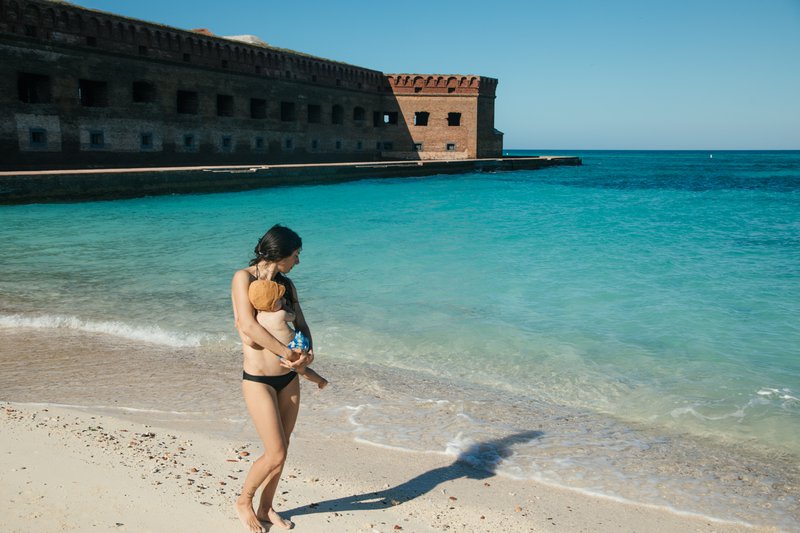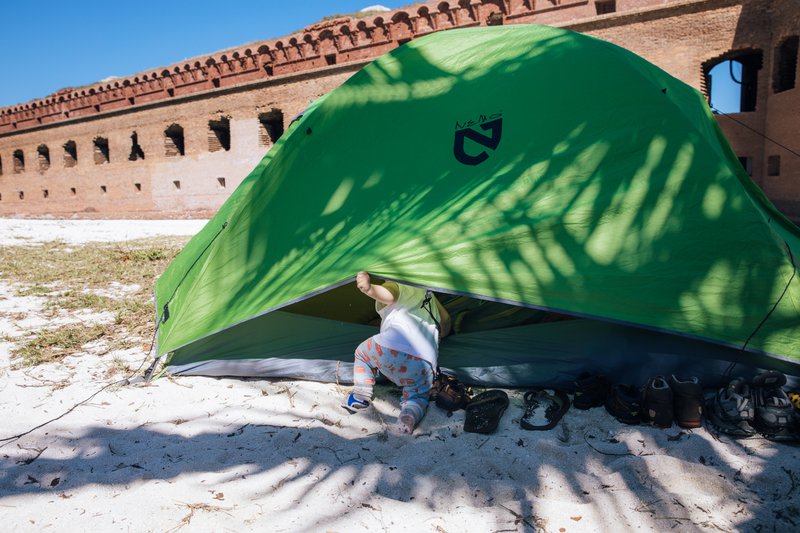Dreaming of Safe Travel: Dry Tortugas
Published on May 07, 2020 - Updated on May 12, 2020
Two Nights in America’s Most Remote National Park

When considering what values would guide our new foray into vanlife, spontaneity and outdoor adventure garnered coveted positions at the top of the list. So when we found ourselves in Southern Florida with a wide open agenda in the first month of our journey, I began searching out options for us to escape the crowds and cliches and replace them with a memorable outdoor experience.
Within minutes I landed on the Dry Tortugas - a remote island chain about 70 miles west of America’s most southern tip, Key West. Nestled closely like a flotilla, the Tortugas are protected on all sides by the vast azure Caribbean Sea which meant a 2 hour high speed catamaran or 45 minute seaplane stood in the way of our visit. Yet, when I discovered that we could camp on the island for up to three nights, I began planning our “week in the keys” around this cornerstone.
The only issue was that the ferries were booked solid, twelve to eighteen months in advance. And the seaplane option would have cost as much as a childbirth - something we expense reducing van lifers could absolutely not afford. Yet I couldn’t stand not being able to create this experience, so I pushed through the laughing receptionist each day for three days and finally was given notice of a one night cancellation. We jumped on it and continued to dial through until another opening appeared extending our trip by another night - perseverance always wins.
Breaking through the frontline just to get access to the Tortugas seemed like the easy part as we nestled into a whirlwind of trip prep. Packing for any adventure both for and with the help of two toddlers can feel like slaying a dragon. Whether it's just going for a trip to the local sledding hill or two nights away in one of America’s most remote National Parks, we’ve learned that sparing comfort is a recipe for adventure-suicide.

At about 8 PM, ten hours before we were expected to board the vessel, we were still navigating the busy streets of Key West searching for safe, cheap and close parking for our bus while we were away and a bit of space to pack for the trip. We scored one and a gear explosion ensued, digging a variety of camping gear out of the way back of the van's gear shed, budgeting the correct number of diapers for our 12 month old, not one but two baby carriers, the stroller, fishing pole, a minimalistic pantry and don’t let me forget all the water we would need for three days as you must pack your own. By 1 AM we were packed and ready to roll.
We awoke the next morning in the dark to check our gear onto the catamaran. More advice here for readers - if you decide to camp out there, do not bring a MSR or Jetboil type stove with canned propane fuel - we found out the hard way at 6 AM. Additionally pack plastic tubs, not bags as the Norwegian rats can chew through just about anything. Anyway, this didn't stop us and by 8 AM we were pulling out of the harbor and heading south west at a ridiculous pace. As quickly as Key West faded so did the cell service as electric blue engulfed our surroundings.

When we docked at Fort Jefferson, the 150+ day trippers offloaded while we six campers stayed aboard to learn the boundaries as set by the Ranger. Finally, after the official safety talk, we were set loose upon the island to set up camp under what little shade could be found. Our last proper camping trips were taken as a family of three on the Maine Island Trail, but as a family of four, there is definitely less spare time to catch up on a book or a nap. Just like living in a home or in a van, with two young kids we found all of our hands were full, all of the time.
At 3 PM the catamaran hastily departed and the island breathed a sigh of relief as over 95% of the daily occupants disappeared - onto their next vacation highlight. Soon the last of the float planes roared out of the harbor and it was only those of us at the five or so campsites, the brave souls who sailed in and were moored offshore and the friendly staff, together who were able to truly see and experience this place without disruption.
Snorkeling in the late afternoon sun was like medicine for our weary bodies after a month of living on the road and six more of life altering decisions to uproot ourselves from our home and set out on this adventure. We were as far south as we could get in the continental US and it felt just right especially after our maiden voyage to Meat Cove, Nova Scotia late in the previous summer connecting way points along our eastern seaboard. While basking in all these feelings, our oldest son donned his swimmies and proceeded to blow our minds doggy paddling out of his comfort zone for over an hour in the tropical blue waters. While he wasn’t able to enjoy the snorkeling, we certainly did, trading half hour spurts of diving off the massive brick fort and the underwater wooden pillars. Everyone clearly needed this.

As we settled into our pre-packaged dinner, the sun met the turquoise waters sending purples and oranges out that mimicked the colors of the reef fish we saw snorkeling during the day. With the heat dissipating, the hermit crabs danced between conch shells all on the most picturesque white sand imaginable. When the kids eventually slept we watched the stars slip into the ocean and back, falling asleep to a gentle lapping just beside our tent.
And this is how our trip unfolded the next two days, snorkeling, tasty meals, exploring Fort Jefferson by foot and by water and dodging the army of hermit crabs and troop of rats trying to steal our food and water each night. We absolutely recommend this adventure to any family considering it, and offer the following advice as some of these things were learned the hard way.
Do:
- Pack food and water in hard sided containers - rats
- Bring cash to pay your $15/night camp fee
- Call Yankee Ferry on short notice to see if you can fill up a cancelled seat
- Consider alternative ways in and out as the park allows you to stay fourteen days, not just three as the ferry mandates
- Consider a kayak, SUP or any other way to get out to the reefs
- Pack pre-made meals like Patagonia Provisions or Good to Go to cut space and waste
Don't:
- Bring too much water - the ferry shows up every day and you can fill your bottles with ice cold water
- Bring your snorkel gear unless you are a pro - they have it for free on the island.
- Try and book an overnight trip a week before in the high season (we were incredibly lucky as most people book 12-18 months out)
- Bring MSR style bottled gas

Additional Tips / Facts
Fort Gorges is the largest brick structure in North America. As a guest you are free to explore most of the Fort at will including the grassy roof top that circles the entire fort structure. The main island however is very small, and you can walk all of it in a couple hours in one morning, if the far end is even open (may close due to bird habitat restoration). The main attraction is swimming and snorkeling.
Snorkeling is the most popular activity and the boat provides snorkeling gear for day trippers. It’s as easy as grabbing some fins, a mask and snorkel and wading into the main snorkeling areas around the Fort and the underwater pillars from old piers.
The campground is as basic as they come, and you are expected to bring everything you would need including water. You will find all ten or so campsites tucked together however most offer some privacy with native plants growing on the island. However, with three hundred guests showing up between 10 AM - 3 PM every day, you will find little privacy during those hours.
The main beach couldn’t be more perfect for kids. It’s white sand beach and turquoise warm waters offer the perfect place to learn to swim. On top of that, the first fifty meters or so stay at about waist deep so kids of all ages can safely play with or without parents in the water.
From 10 - 3, campers are asked to use the restroom facilities on the catamaran. They are cleaned regularly and are spacious. After those hours, there are facilities inside Fort Gorges accessible all of the time.